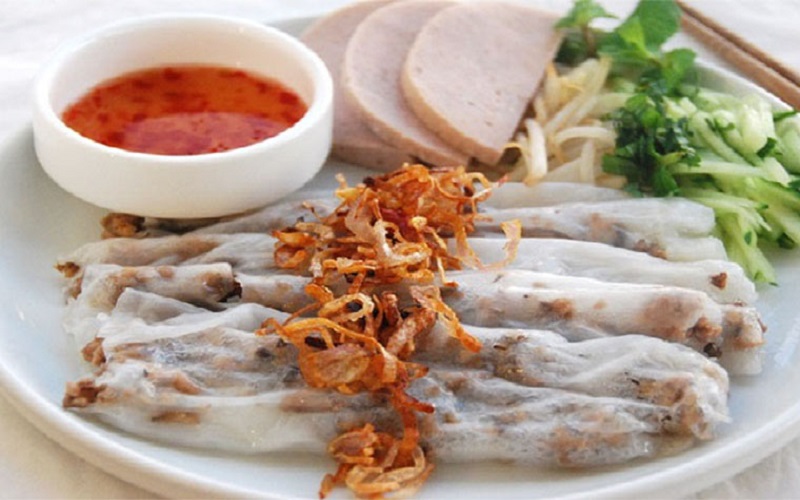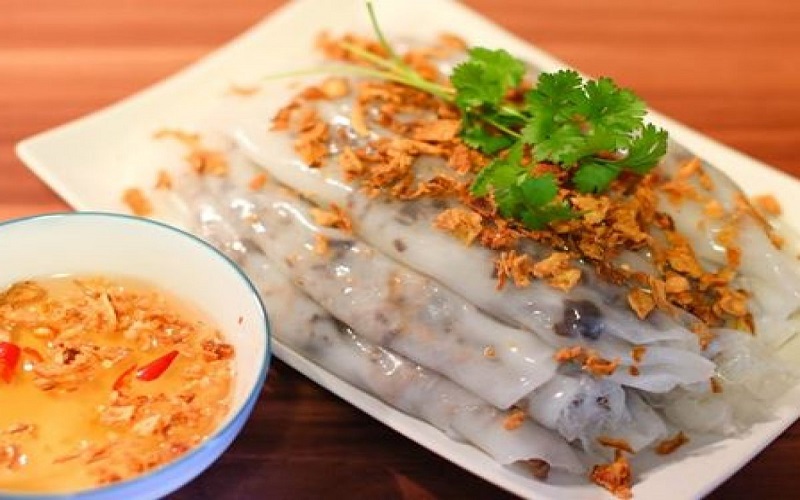Banh Cuon: Recipe & Ingredients of Vietnamese Rice Rolls
What is Banh Cuon? Bánh Cuốn or Vietnamese Steamed Rice Paper Rolls is made from a thin, wide sheet of fermented rice batter filled with a mixture of cooked seasoned ground pork, minced wood ear mushroom, and minced shallots. Sides for this dish usually consist of chả lụa (Vietnamese pork sausage), sliced cucumber, and bean sprouts, with the dipping sauce which is fish sauce called Nước Chấm (Dipping Sauce).

The dish is served with topping and dipping sauce. Light, tasty, and filling are the best words to describe about. It is a preferable breakfast dish and a must-try to truly comprehend the diversity of Vietnamese Cuisine. Each region leaves a different impression on those who try it, but they all share a rich history and cuisine worth sharing. That’s why we are here, sharing the story of Vietnamese steamed rice rolls with you.
1. Origin of Banh Cuon in Vietnam:
Banh Cuon in Vietnam is believed to originate from a small village of Thanh Tri in Hanoi Capital City, stretching along the Red River. Legend story has it that, under the reign of Hung King, people came to this virgin land and started cultivating wet rice – the “spirit and soul” crops of the Vietnamese. Hung King was chosen to be the king thanks to the creation of the rice square and round cakes (also known as Banh Chung – Banh Day); therefore, his children were taught to appreciate the rice grains as the “Pearls of Earth” One of Hung King’s princes, An Quoc, taught his people to make thin and transparent sheets of steamed rice to celebrate the versatility of the rice grains and also the cleverness of his people. In the past, Banh Cuon was a privileged dish, only served on special occasions and celebrations like Vietnamese New Year. However, over time, with the growth of rice cultivation, it was made accessible to every corner of Hanoi.

Thanh Tri village is now recognized as an ancient artisan village for making banh cuon, with more than two-thirds of the population living off this occupation. The techniques of making steamed rice rolls were passed down from generation to generation and the descendants spread out and adapted their traditional dish to their new homes, which consequently created a wide range of Banh Cuon varieties across the country nowadays.
2. Some Types of Banh Cuon in Vietnam:
First of all, it is necessary to distinguish between Banh Cuon and Banh Uot, which is literally translated into “wet cakes.” It confuses us sometimes with the name since they are not wet as they are named but moist and super soft. Banh Cuon and banh uot are basically relatives in which banh uot is Banh Cuon without fillings. These two are always available together on the menu because they have exactly the same ingredients and cooking methods, so it is convenient to have them both for more options.
Given its large territory and various climates, it’s not surprising that a dish like Banh Cuon has many different versions. Usually, just a small variation in the fillings, dipping sauce, or toppings can create a completely new Banh Cuon eating experience.

- Banh Cuon Thanh Tri (Hanoi): Thanh Tri is known as the home and artisan village of steamed rice rolls. It has its own secrets recipe and ingredients for making its Banh Cuon stand out. Firstly, good-quality rice grains are selected, soaked for around three hours, and rinsed before being used in the following stages. Despite the presence of technology, in Thanh Tri, rice is still ground using a traditional stone grinder. Rice powder made in this way retains its natural rice aroma and creates a shiny surface after steaming. Another unique feature of Banh Cuon Thanh Tri is that it is made into super thin sheets before being rolled up. It is believed that the thinner the steamed rice sheets, the more experienced and skillful the chefs are.
The most profound highlight of Banh Cuon Thanh Tri, however, is the dipping sauce made from ca cuong (Lethocerus indicus) – a type of water bug widely eaten in Southeast Asia. The male ones possess two bags of essential oil which are used as a defensive weapon and are also considered nutritious parts. The essential oil from ca cuong is extracted, has a decent cinnamon scent, and a slightly sour taste, and is stored for making dipping sauce. Due to the declining population of these native insects, artificial ca cuong oil is used as an alternative, while the natural one is rarely used, or only used for privileged customers.

Scattering around the northern part of Vietnam, there are countless interesting varieties of banh cuon. Here to name a few:
- In Ha Nam – the southern gateway of Hanoi, Banh Cuon is eaten cold with chargrilled pork and warm dipping sauce.
- In Quang Ninh Province – one of the biggest provinces along the coastline of Vietnam and home to the World Heritage Site Ha Long Bay, Banh Cuon is eaten with fried squid cakes which are also the food specialty of the city.
- In Thanh Hoa Province – the northern tip of Central Vietnam, city famous with Nem Chua, Banh Cuon is sometimes made without meat fillings and eaten with eel congee.
- In Nghe An Province – the hometown of President Ho Chi Minh, Banh Cuon is eaten with boiled pork organs or with eel soup.
- In Ha Tinh Province – neighboring Nghe An, steamed rice rolls are eaten with corn egg rolls, which is a tasty combination of soft steamed rice rolls and crispy egg rolls.
- In Quy Nhon Province - Banh Cuon Quy Nhon is probably the most notable in Central Vietnam. Quy Nhon, a coastal city located in the southeast of Binh Dinh Province, has diverse landscapes and is still quite underexploited. The difference in Banh Cuon Quy Nhon lies in the way it is presented, with the rice paper rolls, toppings, and vegetables placed on separate plates. Additionally, it is common to eat steamed rice sheets as a side dish with pork organ congee.
- Banh Cuon in Ho Chi Minh City (Saigon) does not have a fixed recipe. The strong competition in this populous city requires every restaurant to have its unique blend to stand out. One of the creative recipes worth mentioning is Banh Cuon trung (egg rice-rolled cakes). There are two versions of Banh Cuon trung: eggs can either be mixed with the rice batter or wrapped inside the batter so they remain runny when cut into the rice wrappers.
Another variation is Banh Cuon la dua (pandan steamed rice-rolled cakes). Pandan is an indigenous plant that is a common natural coloring in Vietnamese cuisine. The rice batter is mixed with pandan extract to create a pleasant fragrance and eye-catching color.
- Banh Cuon Nguoi Hoa (Chinese-Vietnamese steamed rice rolls): The Chinese-Vietnamese community has greatly contributed to the culinary diversity in Vietnam. In terms of steamed rice rolls, their batter is often enhanced with large quantities of green onions and the fillings show a strong Chinese influence with char siu or fresh shrimp (which are quite similar to the fillings in their dim sum). Another distinct characteristic of this type of Banh Cuon is that it is dipped in soy sauce instead of fish sauce.
3. Recipe and Ingredients of Banh Cuon:
- Wet Rice Paper Wrappers:
Youtube and other social media probably show you some tips to get around for convenient making of the rice wrappers (such as using ready-made rice paper sheets, using packaged pre-mixed Banh Cuon flour, using a non-stick pan for making the wrappers, and so on). However, traditionally, it is believed that Banh Cuon should be made by grounding your own rice and steaming it on a conventional steamer. This process surely requires more time and effort, but it also guarantees the uniqueness of each final product.
To make banh cuon, the rice grains are finely milled using a stone mill or blender. The rice flour is then soaked in cool water for at least 4 hours, which removes unwanted materials, eliminates any mossy odor, and makes the wrappers softer and shinier after steaming. The longer the rice flour is soaked, the more flexible and elastic it becomes. If soaking overnight is not possible, adding tapioca starch will help make the wrappers softer and more elastic. The mixture can be flavored with pandan leaf extract, coconut milk, or eggs, depending on personal preference.
A traditional steamer is set up with a thin fabric sheet on top. When the water boils, the fabric is covered with vegetable oil and a ladle of batter is poured and spread evenly. The rice wrapper is cooked for about a minute and then removed from the fabric using a bamboo stick and placed on a tray to be filled with the desired ingredients.
- Some Filling Ingredients:
Typically, the filling for Banh Cuon is a mixture of minced pork and wood-ear mushrooms, combined with diced onions and jicama. These vegetables keep the filling moist and flavorful. The mixture is stir-fried and ready to be wrapped in steamed rice sheets.
- Ingredients for Toppings:
Banh Cuon is commonly served with a variety of Vietnamese cold cuts called cha and nem. These toppings are very common in Vietnamese dishes. A plate of Banh Cuon typically includes at least three types of cha, such as cha lua (steamed pork sausage), cha chien (fried pork sausage), and cha que (fried cinnamon pork sausage). These Vietnamese sausages have a chewy texture and a slightly fatty taste. Nem, on the other hand, is a type of fermented pork wrapped inside banana leaves. They are little pink cubes seasoned with chilies, garlic, and whole pepper grains.
Another essential topping is banh tom (deep-fried shrimp cakes). Banh tom is a small round cake made from a mixture of rice flour, cassava flour, and turmeric powder, with a whole shrimp placed on top. Sometimes, the shrimp is minced and mixed directly with the batter before frying, and adding green beans can make it nuttier and tastier. The crispy banh tom combined with the chewy cha and soft rice wrappers makes for a well-balanced combination.
Finally, the dish is completed with blanched bean sprouts, sliced cucumber, and herbs. These vegetables have a light, fresh taste, adding crunchiness to the dish and also serving as a source of fiber.
- Dipping Sauce:
The dipping sauce is easily made by boiling fish sauce with water and sugar. The sauce is simply balanced between saltiness and sweetness. Minced chilies can be added separately when eating according to personal preference.
4. Best Places/Restaurants to Eat Banh Cuon?
Steamed rice rolls are always freshly made by order. A plate of Banh Cuon is still steaming when it is served, which guarantees a delicious and nutritious meal. We hope the information and tips will come in handy for you to experience this favorable local dish. Check out our recommendations where to eat below and add the nearby to your to-do list.
- Hanoi Capital City:
-
Banh Cuon Ba Hoanh (Ba Hoanh Rice Paper Roll)
- Address: 66 To Hien Thanh, Hoan Kiem District, Hanoi
- Price: 25,000 VND – 35,000 VND ($1 – $1.4)
-
Bánh Cuốn Phượng – Đào Duy Từ
- Address: 16 Đào Duy Từ, Hoàn Kiếm, Hanoi Old Quarter
- Phone: 0769 144 007
- Opening Hours: 6:00 - 21:00
-
Bánh cuốn bà Xuân
- Address: 16 Dốc Hòe Nhai, Ba Đình, Hà Nội
- Phone: 0968404665
- Opening Hours: 07:00 - 12:00 | 16:00 - 00:30
-
Bánh cuốn Thanh Vân
- Address: 12-14 Hàng Gà, District Hoàn Kiếm, Hanoi
- Opening Hours: 06:30 - 14:00 | 17:00 - 22:00
-
Bánh cuốn Bà Hanh
- Address: 26B Thọ Xương, Hoàn Kiếm, Hà Nội
- Hotline: 0961669626
- Website: banhcuonbahanh.com
- Opening Hours: 06:00 - 14:00 & 16:00 - 22:00
-
Bánh cuốn Quang An
- Address: 71 Hàng Bồ, District Hoàn Kiếm, Hà Nội
- Opening Hours: 16:00 - 23:00
-
Bánh cuốn Phủ Lý
-
Address:
- CS1: 14 Cửa Bắc, Trúc Bạch, Ba Đình, Hà Nội
- CS2: 39 Đào Duy Từ
- Phone: 090 440 50 05
- Opening Hours: 8:30 - 22:00
-
Address:
-
Bánh cuốn - 57A Hàng Bồ
- Address: 57A Hàng Bồ, District Hoàn Kiếm, Hà Nội
- Opening Hours: 6:00 - 12:00
-
Bánh cuốn Cao Bằng
-
Address:
- 2 Lane 16 Huỳnh Thúc Kháng, District Đống Đa, Hà Nội
- 11b Thể Giao, Hai Bà Trưng, Hà nội
- Opening Hours: 06:00 - 21:00
-
Address:
-
Bánh Cuốn Phượng - Hàng Cót
- Address: 68 Hàng Cót, District Hoàn Kiếm, Hanoi French Quarter
- Opening Hours: 07:00 - 11:00 | 16:00 - 21:00
- Saigon/Ho Chi Minh City:
-
Banh Cuon Hong Hanh (Hong Hanh Rice Paper Roll)
- Address: 17A Nguyen Thi Minh Khai, District 1, Ho Chi Minh
- Price: 41,000 VND – 61,000 VND
-
Banh Cuon Hai Nam (Hai Nam Rice Paper Roll)
- Address: 11A Cao Thang, District 3, Ho Chi Minh City
- Price: 38,000 VND – 42,000 VND
- Da Nang City in Central Vietnam:
-
Banh Cuon Tien Hung (Tien Hung Rice Paper Roll)
- Address: 190 Tran Phu, Hai Chau District, Danang
- Price: 30,000 VND – 35,000 VND
-
Banh Cuon Hai Hue (Hai Hue Rice Paper Roll)
- Address: 47 Ngo Gia Tu, Hai Chau District, Danang
- Price: 25,000 VND – 35,000 VND
See Also:

Best of Vietnam

Best Vietnamese Food You Have to Try in Vietnam
Best Food in Vietnam: Vietnamese Traditional Food is top World well known to be both healthy and...

10 Best National Parks in Vietnam
Vietnam Travel Guide: If you look for the Best Wildlife Discovery Experience in Vietnam, here are...
Read More
Best Souvenir to Buy in Vietnam
If you look for Best Things to Buy when traveling to Vietnam to bring home for your family & friends...
Read More
The 10 Best Places to Visit in Vietnam
Vietnam Travel Guide: Home to an extensive collection of historical and cultural attractions,...
Read More
Top 10 Museums You Should Not Miss in Vietnam
Vietnam, 4.000 years old country has a unique and lengthy history, culture with 54 ethnic groups. It...
Read MoreFind your trip
Vietnam Best Tours
Vietnam Car Rental
Vietnam Travel Blog
- Vietnamese People: Origin, History, Culture and Traditions
- Vietnam Currency: Best ATM and Places to Exchange Money
- Vietnam Map: Regions, Cities & Provinces Map of Vietnam
- What is illegal Things in Vietnam: Rules & Laws for Tourists
- Best Time to Travel to Vietnam to Avoid the Bad Weather
- Vietnam News: Population & Religions of 54 Ethnic Groups









